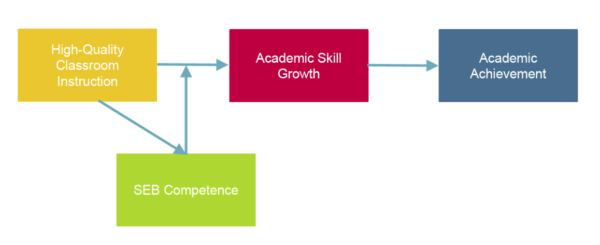What is Social Emotional Behavior (SEB)?
In the past, a traditional school of thought posited that students are successful in school if they’re academically successful, and that if students are demonstrating academic achievement, they’ll be “fine” overall.
More and more, researchers are pointing to the short-sightedness of the view (Taylor & Kilgus, 2014). Research in fact shows that students are more successful in school when they are also able to demonstrate social-emotional and behavioral (SEB) competence (Denham, 2006; Kwon et al., 2012).
What is social emotional behavior (SEB)?
SEB competence is defined by the presence of social-emotional and academic enabling skills that help students learn and relate to others (e.g., self-awareness, social awareness, self-management, relationship skills, responsible decision-making, motivation, and academic achievement). SEB competence is also defined by the absence of problem behaviors that prohibit learning and healthy relationships (e.g, aggression, noncompliance, disruption, worry/fear, and withdrawal/avoidance).
Social emotional behavior competence as a protective factor
Research shows that SEB competence can serve as a protective factor. Students who are exposed to a number of risk factors, such as the limited availability of resources in the home and community, are more likely to achieve academically if they have demonstrated SEB competence (Elias & Haynes, 2008)
Social emotional behavior competence as a mediator
SEB functioning is also a mediator between high-quality instruction and academic growth. It is commonly assumed that high-quality classroom instruction will lead directly to academic skill growth and eventually to overall academic achievement.
Research tells us that this isn’t necessarily the case for all students. Instead, educators can think of SEB competence as a mediator between instruction and achievement. If students are struggling with an SEB skill—for instance, not attending to instruction, not studying for quizzes and tests, struggling to get along with others, struggling to effectively participate in an academic groups, or struggling to work independently—it will impede that student’s ability to access that high-quality instruction and build the academic skills over time that lead to mastery of grade-level standards.

Based on DiPerna (2006).
How is social emotional behavior competence nurtured?
SEB competence is nurtured through a combined learning approach that addresses both social-emotional skills and behavior, often as part of the district’s multi-tiered system of support (MTSS).

To learn more about implementing SEB assessments to align targeted supports, watch Dr. Kilgus’ on demand webinar “Using Social-Emotional and Behavioral Assessments to Support MTSS.”
Illuminate’s assessment tools are the only K-12 solution to provide screening and progress monitoring across math, reading, and SEB functioning. To learn how you can use Illuminate’s assessment solution to inform teaching and support students’ learning needs—whether in an onsite, remote, or hybrid environment—contact us to schedule a demo.
*****
Illuminate Education partners with K-12 educators to equip them with data to serve the whole child and reach new levels of student performance. Our solution brings together holistic data and collaborative tools and puts them in the hands of educators. Illuminate supports over 17 million students and 5200 districts/schools.
Ready to discover your one-stop shop for your district’s educational needs? Let’s talk.

